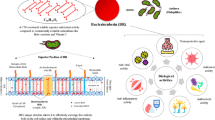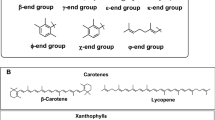Abstract
Iron-sufficient Azotobacter salinestris cells bound large amounts of 55Fe to cell-associated catechol melanin in an energy-independent manner. Iron was mobilized from the cell surface by citric acid and transported into the cell in a process that was inhibited by azide, carbonyl cyanide m-chlorophenyl-hydrazone (CCCP), KCl or RbCl, the latter two known to inhibit Na+-dependent activities in A. salinestris. Iron-limited cells produced a hydroxamate compound (HDX) which promoted 55Fe-uptake into iron-limited cells in a two step process. Initial uptake was inhibited by azide or CCCP, but not by KCl, while subsequent uptake was blocked by all inhibitors. Citric acid also mediated energy-dependent 55Fe-uptake in iron-limited cells, but initial iron-uptake was less sensitive to CCCP than HDX-mediated iron-uptake. The results show that melanin serves as an iron trap, probably to protect the cells from oxidative damage mediated by H2O2 and the Fenton reaction. A model for HDX siderophore-mediated iron-uptake is proposed which requires energy to concentrate iron in the periplasm and H+/Na+-dependent events to bring iron into the cell.
Similar content being viewed by others
References
Byers BY, Powell MV, Lankford CE. 1967 Iron-chelating hydroxamic acid (schizokinin) active in initiation of cell division in Bacillus megaterium. J Bacteriol 93, 286–294.
Collinson SK, Page WJ. 1989 Production of outer-membrane proteins and an extracellular fluorescent compound by ironlimited Azomonas macrocytogenes. J Gen Microbiol 135, 1229–1241.
Csaky TZ. 1948 On the estimation of bound hydroxylamine in biological materials. Acta Chem Scand 2, 450–454.
Emery T, Neilands JB. 1960 Contribution to the structure of ferrichrome compounds: characterization of the acyl moieties of the hydroxamate functions. J Am Chem Soc 52, 3658–3662.
Fekete FA, Lanzi RA, Beaulieu JB, et al. 1989 Isolation and preliminary characterization of hydroxamic acids formed by nitrogen-fixing Azotobacter chroococcum B-8. Appl Environ Microbiol 55, 298–305.
Geremia E, Corsaro C, Baratta D, Santoro C, Scalia M, Sichel G. 1989 Antioxidant enzymatic systems in pigment tissue of amphibia. Pigment Cell Res 2, 208–212.
Gutteridge JM. 1987 Ferrous-salt-promoted damage to deoxyribose and benzoate. Biochem J 243, 709–714.
Halliwell B, Gutteridge JMC. 1988 Iron as a biological prooxidant. ISI Atlas Sci: Biochem 1, 48–52.
Knosp O, von Tigerstrom M, Page WJ. 1984 Siderophoremediated uptake of iron in Azotobacter vinelandii. J Bacteriol 159, 341–347.
Krieg NR, Hoffman PS. 1986 Microaerophily and oxygen toxicity. Annu Rev Microbiol 40, 107–130.
Mason HS, Ingram DJE, Allen B. 1960 The free radical properties of melanin. Arch Biochem Biophys 86, 225–230.
Neilands JB. 1952 A crystalline organo-iron pigment from a rust fungus (Ustilago sphaerogena). J Am Chem Soc 74, 4846–4847.
Neilands JB. 1981 Microbial iron compounds. Annu Rev Microbial 50, 715–731.
Nikaido H. 1993 Uptake of iron-siderophore complexes across the bacterial outer membrane. Trends Microbiol 1, 5–8.
Page WJ. 1986 Sodium-dependent growth of Azotobacter chroococcum. Appl Environ Microbiol 51, 510–514.
Page WJ. 1987 Iron-dependent production of hydroxamate by sodium-dependent Azotobacter chroococcum. Appl Environ Microbiol 53, 1418–1424.
Page WJ. 1991 Examination of the role of Na+ in the physiology of the Na+-dependent soil bacterium Azotobacter salinestris. J Gen Microbiol 137, 2891–2899.
Page WJ. 1993 Growth conditions for the demonstration of siderophores and iron-repressible outer membrane proteins in soil bacteria, with an emphasis on free-living diazotrophs. In: Barton LL, Hemming BC, ed. Iron Chelation in Plants and Soil Microorganisms. San Diego: Academic Press; 75–109.
Page WJ, Huyer M. 1984 Derepression of the Azotobacter vinelandii siderophore system, using iron-containing minerals to limit iron repletion. J Bacteriol 158, 496–502.
Page WJ, Jackson L, Shivprasad S. 1988 Sodium-dependent Azotobacter chroococcum strains are aeroadaptive, microaerophilic, nitrogen-fixing bacteria. Appl Environ Microbiol 54, 2123–2128.
Page WJ, Shivprasad S. 1991 Azotobacter salinestris sp. nov., a sodium-dependent, microaerophilic, and aeroadaptive nitrogen-fixing bacterium. Int J Syst Bacteriol 41, 369–376.
Pilas B, Sarna T, Kalyanaraman B, Swartz HM. 1988 The effect of melanin on iron associated decomposition of hydrogen peroxide. Free Radical Biol Med 4, 285–293.
Porebeska-Bundy M, Sakina NL, Stepien KB, Dontsov AE, Wilczok T. 1992 Antioxidant activity of synthetic melanins. Cardiolipin liposome model. Biochim Biophys Acta 1116, 11–16.
Postle K. 1990 TonB and the gram-negative dilemma. Mol Microbiol 4, 2019–2025.
Scalia M, Geremia E, Corsaro C, Santoro C, Baratta D, Sichel G. 1990 Lipid peroxidation in pigmented and unpigmented liver tissues: protective role of melanin. Pigment Cell Res 3, 115–119.
Shivprasad S. 1991 Physiological response of sodium-dependent Azotobacter chroococcum strain 184 to oxygen stress. PhD Thesis. University of Alberta, Edmonton.
Shivprasad S, Page WJ. 1989 Catechol formation and melanization by Na+-dependent Azotobacter chroococcum: a protective mechanism for aeroadaptation? Appl Environ Microbiol 55, 1811–1817.
Sichel G, Corsaro C, Scalia M, Sciuto S, Geremia E. 1987 Relationship between melanin content and Superoxide dismutase (SOD) activity in the liver of various species of animals. Cell Biochem Function 5, 123–128.
Author information
Authors and Affiliations
Rights and permissions
About this article
Cite this article
Page, W.J., Shivprasad, S. Iron binding to Azotobacter salinestris melanin, iron mobilization and uptake mediated by siderophores. Biometals 8, 59–64 (1995). https://doi.org/10.1007/BF00156159
Received:
Accepted:
Issue Date:
DOI: https://doi.org/10.1007/BF00156159




